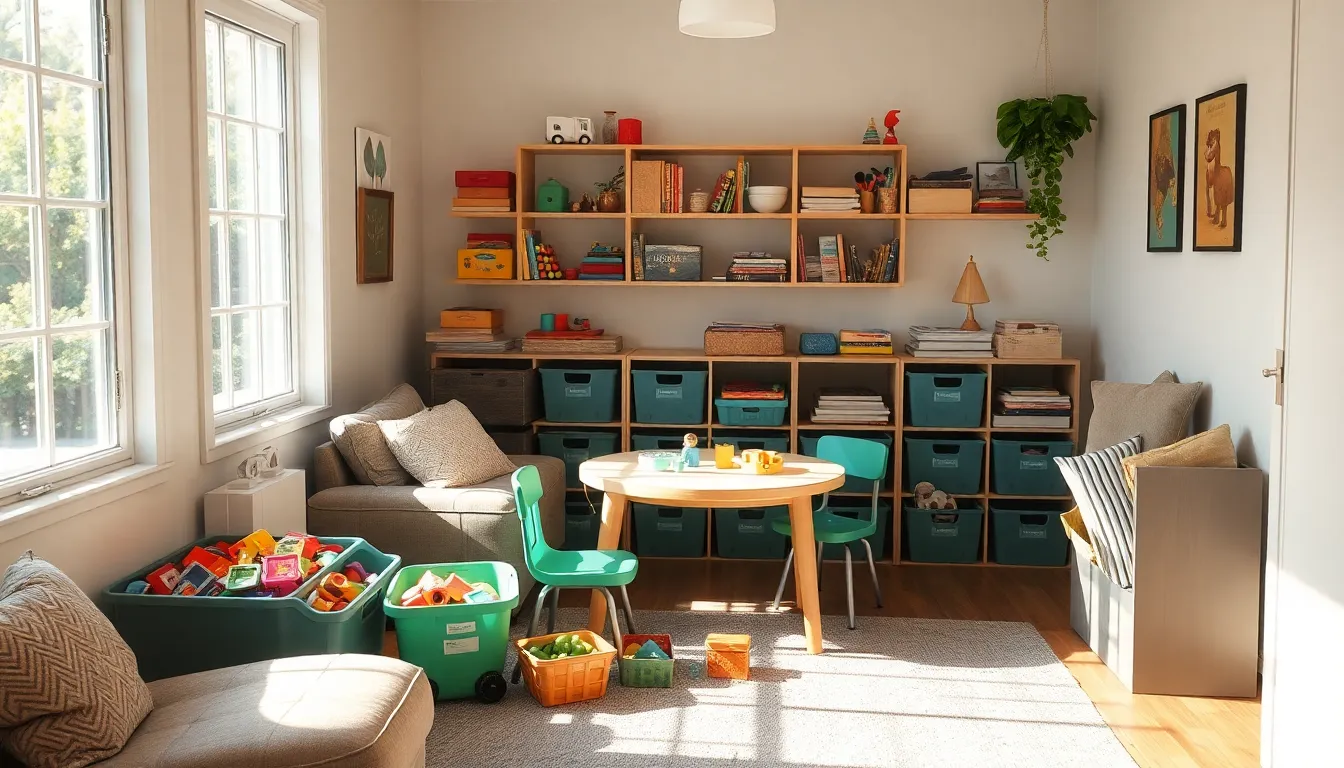Table of Contents
ToggleActive learning transforms children from passive listeners to engaged explorers. Parents play a crucial role in fostering this development, but many struggle to find effective strategies that work in everyday situations. The right approach can turn mundane moments into valuable learning opportunities.
Today’s parents face unique challenges in balancing screen time with hands-on experiences. While digital tools offer educational benefits, nothing replaces the power of interactive, real-world learning. Fortunately, incorporating active learning doesn’t require expensive materials or extensive planning—just intentional engagement and a willingness to follow your child’s natural curiosity.
What Is Active Learning and Why It Matters for Children
Active learning transforms children from passive recipients of information into engaged participants who construct knowledge through direct experiences and personal discovery. This educational approach emphasizes hands-on exploration, critical thinking, and meaningful interaction with the environment rather than simple memorization of facts.
Children engaged in active learning ask questions, solve problems, and make connections between new information and what they already know. They manipulate objects, experiment with concepts, and collaborate with others – activities that spark their natural curiosity and drive deeper understanding. Research from the Harvard Center on the Developing Child confirms that these interactive experiences build stronger neural connections than passive learning methods.
Active learning benefits children’s development in several key ways:
- Cognitive growth – Children develop stronger problem-solving abilities and critical thinking skills when they discover concepts through experimentation
- Improved retention – Information connected to personal experience creates lasting memories compared to passively heard facts
- Enhanced creativity – Hands-on exploration encourages innovative thinking and unique approaches to challenges
- Stronger social skills – Collaborative active learning fosters communication abilities and teamwork
- Greater motivation – Children develop intrinsic motivation when they experience the satisfaction of solving problems themselves
This learning approach matters because it prepares children for success beyond academic achievement. Active learners develop the adaptability, curiosity, and self-direction needed to thrive in a rapidly changing world. They’re equipped with skills that extend far beyond standardized tests – they become lifelong learners who approach new situations with confidence and curiosity.
Creating an Active Learning Environment at Home
Transforming your home into a vibrant learning environment doesn’t require a complete renovation or expensive materials. Parents can establish spaces and routines that naturally encourage exploration, curiosity, and engagement with just a few thoughtful adjustments.
Setting Up Dedicated Learning Spaces
Dedicated learning spaces signal to children that discovery and exploration are valued activities in your home. These areas don’t need to be elaborate—even a corner of a room with a small table, comfortable seating, and accessible materials works effectively. Position these spaces in well-lit areas, preferably with natural light, as proper lighting improves focus and reduces eye strain. Keep the space organized with labeled bins or shelves where children can independently access and return materials. Rotate items periodically to maintain interest and spark new ideas. Consider incorporating elements that reflect your child’s current interests, whether dinosaurs, space, or nature. Multi-purpose spaces that adapt to different activities—from art projects to reading nooks to science experiments—maximize functionality in homes with limited room. The physical environment significantly impacts learning behavior, with thoughtfully arranged spaces encouraging longer engagement and deeper concentration.
Gathering Age-Appropriate Materials
Curating age-appropriate learning materials creates opportunities for meaningful engagement without overwhelming children. Open-ended items such as building blocks, art supplies, and manipulatives offer versatility across developmental stages and encourage creative thinking. Household objects like measuring cups, safe kitchen tools, and recyclables provide rich learning experiences without additional cost. Books remain essential components of any learning collection—include fiction, non-fiction, reference materials, and topic-specific texts based on current interests. Rotate materials every few weeks to maintain novelty and expand learning possibilities. Storage solutions like clear containers allow children to see available options and promote independence in selecting activities. Consider creating themed kits (science exploration, dramatic play, art studio) that group related materials together for cohesive learning experiences. Quality trumps quantity—fewer well-chosen items often generate more sustained engagement than numerous options that create choice paralysis or scattered attention.
Effective Active Learning Strategies for Parents
Parents can implement several proven strategies to enhance their children’s active learning journey. These approaches build on the foundational elements of an effective learning environment while encouraging children to become more engaged and self-directed learners.
Learning Through Play Techniques
Play serves as children’s natural method for exploring and understanding their world. Parents can leverage this innate drive by incorporating guided play activities that balance child-led exploration with subtle adult direction. Set up simple scenarios like grocery store simulations using household items to develop math skills through “shopping” and “making change.” Block play encourages spatial reasoning, engineering concepts, and problem-solving as children construct increasingly complex structures. Sensory activities—such as water play with measuring cups or creating texture boards from various materials—develop scientific thinking and vocabulary. Role-playing games foster creativity, language development, and social skills when children take on different characters. Games with rules teach turn-taking, fairness, and strategic thinking while still maintaining the fun element that keeps children engaged and motivated.
Inquiry-Based Learning Approaches
Inquiry-based learning transforms children from passive recipients of information into active investigators. Parents can spark curiosity by asking open-ended questions that encourage deeper thinking, such as “What do you think would happen if…?” rather than questions with one-word answers. Creating wonder walls where children post questions about topics they’re curious about provides direction for family explorations. Parents can follow their child’s interests by visiting relevant museums, checking out library books on the subject, or conducting simple home experiments. Modeling curiosity by openly wondering about everyday phenomena encourages children to do the same. Family projects focused on solving real problems—designing a better bird feeder or planning a garden—develop research skills and critical thinking. Documentation of investigations through photos, drawings, or recordings helps children reflect on their learning process and solidifies their understanding of discovered concepts.
Incorporating Movement into Learning Activities
Physical movement significantly boosts children’s cognitive function and information retention. When children engage their bodies during learning, they create stronger neural pathways and maintain higher levels of engagement with educational content.
Brain Break Ideas That Enhance Focus
Brain breaks provide essential cognitive reset opportunities during learning sessions. Children benefit from short movement intervals every 20-30 minutes, which help restore attention and prevent mental fatigue. Simple activities like “Simon Says” incorporate following directions while getting bodies moving. The “Animal Walk” challenge encourages kids to move like different creatures—slithering like snakes or hopping like rabbits—activating different muscle groups while providing sensory stimulation. “Freeze Dance” combines music appreciation with self-control as children dance freely but must stop instantly when the music pauses. Breathing exercises, such as “Balloon Breaths” (inhaling deeply and exhaling slowly) help children regulate emotions and refocus their attention. These quick activities take only 3-5 minutes yet yield significant improvements in concentration and learning readiness.
Physical Activities That Reinforce Concepts
Learning becomes more concrete when physical movement reinforces academic concepts. Math skills develop naturally during “Hopscotch Counting,” where children jump through numbered squares while skip counting or solving simple equations. Letter recognition improves with “Alphabet Yoga,” as children form letter shapes with their bodies. Science concepts come alive during nature scavenger hunts, encouraging observation and classification while exploring outdoors. Children grasp measurement principles by using their bodies as measuring tools—counting how many “hand spans” an object measures or comparing their height to household items. Storytelling incorporates movement when children act out character actions or emotions, enhancing reading comprehension and narrative understanding. Research from pediatric development studies confirms that these movement-based learning activities result in 30% better information retention compared to sedentary learning approaches.
Technology and Active Learning: Finding Balance
Technology offers valuable educational opportunities for children when used thoughtfully alongside traditional active learning approaches. Finding the right balance between screen time and hands-on experiences creates an optimal learning environment that leverages the benefits of both worlds.
Screen Time Guidelines for Different Ages
Age-appropriate screen time limits protect children’s development while allowing them to benefit from quality digital content. Infants and toddlers under 18 months should have minimal to no screen exposure except for video chatting with family. Children aged 2-5 years benefit from limiting screen time to 1 hour per day of high-quality programming, preferably co-viewed with parents. Elementary-aged children (6-10 years) can handle 1-2 hours daily of educational content, with clear boundaries between learning and entertainment. Tweens and teens (11+ years) typically require more nuanced approaches focusing on content quality rather than strict time limits.
The American Academy of Pediatrics recommends establishing “screen-free zones” in bedrooms and during mealtimes to preserve family connections. Parents can implement the 20-20-20 rule: after 20 minutes of screen time, look at something 20 feet away for 20 seconds to reduce eye strain and maintain physical awareness.
Quality Digital Resources for Interactive Learning
Educational apps and platforms that prompt active participation deliver significant learning benefits compared to passive consumption. PBS Kids offers research-backed games that develop specific skills while engaging children through familiar characters. Kahoot transforms learning into social experiences through customizable quizzes and challenges that promote discussion. Khan Academy provides comprehensive, self-paced learning across numerous subjects with progress tracking features.
Coding platforms like Scratch Jr introduce computational thinking to children as young as 5 through creative problem-solving activities. Digital field trips through platforms such as Google Arts & Culture allow exploration of museums, historical sites, and natural wonders otherwise inaccessible to many families. The best digital resources feature adaptive learning technologies that adjust difficulty based on a child’s responses, providing appropriately challenging content.
Parents can evaluate digital resources by checking for open-ended questions, collaborative opportunities, and activities that bridge screen learning with real-world applications.
Supporting Your Child’s Natural Curiosity
Children possess an innate drive to explore and understand the world around them. This natural curiosity forms the foundation for meaningful learning experiences and cognitive development when properly nurtured and supported.
Asking Open-Ended Questions
Open-ended questions spark deeper thinking and extend children’s learning beyond simple yes/no responses. Questions beginning with “what,” “how,” and “why” encourage children to analyze, predict, and express their unique perspectives. For example, instead of asking “Did you like that story?” try “What was your favorite part of the story and why?” This simple shift transforms interactions into opportunities for language development and critical thinking.
Parents can incorporate these questions during everyday activities—while reading books, exploring nature, or even preparing meals. Research from the Center on the Developing Child at Harvard University shows that back-and-forth conversations stimulated by open-ended questions strengthen neural connections related to language processing and reasoning. These conversations also demonstrate to children that their thoughts and ideas are valued, boosting their confidence in expressing themselves.
Following Your Child’s Interests
Children engage most deeply with learning experiences connected to their personal interests and passions. Parents who observe and respond to these interests create powerful learning opportunities that capitalize on intrinsic motivation. A child fascinated by dinosaurs, for instance, might eagerly absorb complex scientific concepts, vocabulary, and historical information that would otherwise seem overwhelming.
Expanding on these interests happens naturally through related resources like books, museum visits, or hands-on projects that connect to their passion. This interest-led approach leads to more sustained attention spans and greater information retention. Studies from the National Association for the Education of Young Children indicate that children learn approximately 40% more effectively when the material connects to their existing interests. Parents can document these interests through photos or journals, creating a responsive learning environment that evolves with their child’s changing curiosities and developmental needs.
Overcoming Challenges in Active Learning
Active learning journeys often encounter obstacles that can discourage both parents and children. Recognizing these challenges and developing strategies to overcome them strengthens the learning experience and builds resilience for future educational endeavors.
Dealing with Resistance and Frustration
Children’s resistance to active learning activities stems from various sources including fear of failure, boredom, or difficulty with the task. Parents can address this resistance by breaking complex activities into manageable steps that provide small victories along the way. When a child shows frustration, implementing a “pause and pivot” approach allows them to take a break before returning with fresh perspective. Acknowledging their feelings validates their experience: “I see you’re feeling frustrated with this puzzle. That’s okay – challenging activities help our brains grow stronger.” Modeling persistence through personal examples demonstrates that struggle is a normal part of learning. Research from the American Academy of Pediatrics indicates that children who learn to work through frustration develop stronger problem-solving skills and emotional regulation abilities. Creating a low-pressure environment where mistakes are celebrated as learning opportunities reduces resistance over time.
Adapting Approaches for Different Learning Styles
Children process information through distinct learning preferences that significantly impact their engagement with educational activities. Visual learners connect with color-coded materials, charts, and demonstrations they can observe. Auditory learners benefit from discussions, songs, and verbal instructions that allow information processing through listening. Kinesthetic learners thrive when physically manipulating objects or moving their bodies during learning experiences. Parents can identify their child’s learning style by observing when they seem most engaged and retaining information effectively. Multiple learning modalities can be incorporated into a single activity – reading a story (auditory) while showing pictures (visual) and acting out characters (kinesthetic). Educational psychologist Howard Gardner’s multiple intelligences theory supports that children possess different intellectual strengths, from linguistic to spatial to interpersonal intelligence. Tailoring activities to match these natural inclinations creates more meaningful and effective learning experiences.
Conclusion
Active learning empowers children to become architects of their own knowledge through hands-on exploration and discovery. Parents don’t need expensive materials or elaborate setups to foster this powerful approach at home. By creating dedicated spaces supporting physical movement blending quality digital content with real-world experiences and following children’s natural curiosity they build stronger neural connections and lifelong learning habits.
The strategies outlined here offer practical ways to transform everyday moments into meaningful learning opportunities. When parents embrace their role as facilitators rather than instructors children develop critical thinking adaptability and self-direction. These skills extend far beyond academics preparing them to thrive in an ever-changing world.
Remember that active learning isn’t about perfection but about the journey of discovery that parent and child take together.





